Week One
How does Sol Lewitt express the notion that “the idea is the machine that makes the art” in his work? What does the artist’s actual hand have to do with the final work in a conceptual art context?
- The thought and planning that goes into the piece is more important than the final product. The idea is what drives the piece, it’s what makes the ‘machine’ produce
- The artist’s actual hand wasn’t technically in the final execution, but he didn’t need to be because his hand was in everything else leading up to it: the planning, the concept, and the decisions
- Because it was conceptual art, it’s the idea that carries the piece, not just the final product
Where do you draw the boundaries around the artworks in this video? What are the artworks? What strategies and tools does Ono use to challenge the viewer? Do you like any of these concept-works? Discuss.
- These artworks seem to be very interactive with viewers and friends. I think the only boundaries are ensuring the safety of others so no one gets hurt in the process of creating the pieces. They all seem to be fairly harmless though so I don’t think that would be an issue
- The artworks are interactive, and cause you to either engage with other people, or the earth. They’re pieces that have to do with shadows, the sun, footprints, or shaking hands, sending letters to your friends
- To challenge the viewers, Ono is encouraging them to interact with other people or the world around them which is often something people avoid. Often us humans get caught up in our busy lives that we forget to engage with others or forget to appreciate the beauty of our planet. Ono’s pieces may put people out of their comfort zone and challenge them to be more attentive to what’s occurring around them.
- I like the artwork where you make a numbered list of times you’ve felt sad and get a pile of rocks that correspond with that number. Then she says to burn the list and appreciate the beauty of the pile of rocks. I think this piece is amazing because it allows someone to acknowledge their sorrows, but not live in them, and encourages the person to look at the beauty in their sorrows at the same time. Not only is this art, but it is an opportunity for someone to pay attention to their emotions and deal with them in a healthy way
Describe two works by Bruce Nauman (include images) where he frames every day actions (non-heroic, banal) as art. How are they “framed” as art, and what does the framing do to our understanding and experience of the actions?
- Double Poke in the Eye
I think this piece is hilarious. It is a simple (and very random) action of two people poking each other in the eyes, yet it is framed in a way to make it art. The fact that it is captured in neon, the banal act is glorified and exaggerated. You simply cannot miss this piece due to its bright colours and flashy performance.
2) Walking in an exaggerated manner around the perimeter of a square
Walking-in-an-exaggerated-manner-around-the-perimeter-of-a-square-1967-68-10-min.ppm
In this piece, Nauman did exactly as it was titled; he walked in an exaggerated manner around the perimeter of a square. He took the most banal act ever (walking) and made it into art. To frame this action as art, Nauman created this piece like how Sol Lewitt created his. The art is in the process, in Nauman’s planning, in the painting of the square on the ground, in the thought process behind his movements, and in the setting up of the camera. It’s not just Nauman’s final performance that is considered art, it is all of the leading up to it as well.
Kilometer Assignment
keeping a strong friendship,
is harder than it seems.
like a plant that needs some water,
our relationship, it needs:
memories to hold on to, and
experiences to gain.
to keep this union going, to
each other we must
remain.
This is an acrostic poem spelling out the word “kilometer”. When you think about a kilometer, your first thought is usually distance. I reflected on that and I began thinking about what distance looks like nowadays, during a pandemic when you feel so close yet so far from all your friends and family. When there’s physical distance separating a relationship, it’s important to remember to continue making memories, putting effort into reconnecting, and encouraging one another as you maintain your bond. This poem is a reminder that distance is okay, but we can’t forget to reach out to one another if we want to keep growing alongside each other.
Week Two
Marina Abramovic:
Art must be beautiful:
- What I appreciate most about this piece is her devotion to her craft. She put 100% of her effort into the artwork to ensure her performance was as moving as it was. The vigorous brushing of her hair was a statement that not only emphasized the meaning of the piece, but also shows that she is willing to sacrifice her body, and the health of her hair, to achieve the performance she was intending to portray.
- My overall impression: being completely honest, this made me very uncomfortable and I didn’t enjoy it at all. At one point in my life after I bleached my hair many times, some pieces started to fall out so hearing her hair ripping as she brushed through it, made me very uncomfortable.
Relation in time:
- I found it fascinating how they did 16 hours leading up to the final performance and the last hour was the section they allowed viewers to experience it
- The visual of the effect of this action over time was very powerful; you could see their hair loosening, their posture becoming more relaxed, and their eyes closing. This shows her dedication, no matter how sore their backs are, or tired they are, they still pushed through to fulfill the performance
Breathing in/Breathing Out:
- This piece seemed to be the most dangerous of all of them. It’s almost as if they were signing up to be slowly suffocated.
- I think the overall message is really powerful – relationships that are so dependent on the other person, leaves you getting hurt. In a relationship, both people must be whole themselves and know how to live on their own without needing the other person.
- The piece called “Rest Energy” also has the same effect – it is portraying the potential damage that can occur when there is a lot of trust in a relationship
The Artist is Present:
- I love how she says there’s 3 different types of Marinas – one is the product of two national heroes and she can do anything she puts her mind to, another is a child whose mother didn’t love her enough, and the last is a person who is able to tap into more spiritual levels
- The artist “bootcamp” that she did seemed to be very fascinating. All of the exercises they did focused on experiencing earth in new ways and paying attention to the little things. They sat outside with a blindfold on, they counted different colours of grains of rice, and they stared at each other in the eyes
- “The hardest thing to do is next to nothing” you have to rely on your own energy and nothing else
- It takes a lot of physical strength do do all of her performances, especially ro do nothing for such a long period of time
- A lot of her performances required fasting, silence, and no motion. Completely avoiding all distractions
- The relation projects – the more successful the performance was, the worse their relationship got in private
- “I feel like I’m Marie Antoinette going to get her head cut off” she says as she’s walking to begin her exhibit Artist is Present
- My Takeaways on her final performance “Artist is Present”:
- The most touching part for me was when Ulay sat in front of her and she broke the idea of sitting still
- The act of her reaching out to him and showing the emotion on her face reminded the viewers that she is a human being and not just a motionless, lifeless machine
- “Without Ulay, the audience is her lover”
- Talking about her looking down before looking at the new person in front of her “everyone gets a clean and personal contact with Marina”
- “She’s treating each person with the same amount of contact and attention”
- “There’s so many reasons why people come to sit in front of me. Some are angry, some are curious… and you feel incredible pain… When they’re sitting in front of me, it’s not about me anymore. Soon I’m just the mirror of their own self.” – Marina
- “For most masterpieces, people sit in front of it for around 30 second. Most people sit in front of Marina for a whole day”
- My final thoughts: it was a lot more emotional than I thought it would be. When you think about the concept or even talk about it with others, sitting and staring at people every single day for months seems absurd. The thought of people having such an emotional and spiritual response also seemed to be a little extreme, but once I saw the documentary I grew more of an appreciation and understanding of Marina’s work. I found it so fascinating how dedicated she was to the execution of the “Artist Is Present”, and how she ensured that each encounter got the same amount of attention from her.
One Hour Photo
In my attic, there is a torn apart old chair wedged up into this ‘window nook’. It is a very sad corner because we didn’t know what we should do with the nook, and we had no other place to put the deteriorating chair. Even though I forget about this corner all the time, there is one creature who doesn’t; my roommates cat. She loves this chair. She climbs on it, sleeps on it, sits on it and stares out the window. She can spend hours on that chair. So that got me thinking, if a cat can spend so much time on this chair, can I sit on it for an hour?
I was up for the challenge. I set a timer and tried to find the most comfortable position (leaning my head and knees on the window like in the photo). Going into this task, I honestly thought it would be easy for me since I’m the type of person who naturally can do nothing for hours on end. The first (what I think was) 15 minutes were easy, I people watched and thought a lot. I wasn’t feeling antsy at all because I was able to occupy myself with my own thoughts. What I think was halfway, was when my back started to hurt and my butt became numb. That wasn’t fun, but I still wasn’t bored at all because I kept myself busy by looking at people outside and guessing their lives. Then I remembered got really cold towards the end of it and I kept hearing my roommates downstairs so I got a little bit of FOMO (fear of missing out). I tried to listen to the muffled conversation to figure out what they’re talking about, which kept me busy for another while. The timer went off sooner than I anticipated, however as I was sitting there, I was eager for the time to be up since I was cold and a little sore.
Overall, this task was a little bit more challenging than I thought it would be for me. It is surprising how physically demanding it is to simply do nothing. As I was sitting there for only an hour, I reflected on the countless days and months Marina Abramovic sat in the exact same position on a rigid wooden chair. Since she faced many new people every day, I can see how she could keep her mind busy and entertained, but it is how long she did that for, and the sacrifices she had to do for her artwork that really impressed me. She fasted every single day, she probably had to train her body, and I am sure she suffered from pain and bodily harm after each day of sitting. After getting a little sore from just one hour, I have so much respect for Abramovic and I admire her so much more for her dedication to her art.
Week 3
Video 1 – Move and manipulate other people’s objects without causing a great disturbance.
Video 2 – Sit right next to a stranger like you know them, while ignoring all the other places you could have sat.
Video 3 – try climbing a free standing ladder.
Video 4 – Try turning a big van around in a very tight space.
Video 5 – As a parent, see how far you can let her child aimlessly wander away without following them.
Video 6 – Not available
For this assignment I don’t have a window that can open completely, so I threw an object off my balcony. In deciding what object I wanted to throw, I was thinking about finding something light that can be carried and pushed around by the wind. I thought a feather or bubbles would be interesting but then I went to blow my nose, and I thought of just throwing a tissue instead (a clean tissue of course). When I threw it off the balcony, I loved how the action didn’t come from me throwing the tissue. It came from the wind that immediately swooped in to toss it around in the street. I didn’t even have to be there for the movement to occur, I could’ve just let the wind do its thing. I also found it interesting how it moved like how I would imagine a snowflake would move because they’re both flat and light objects. It was funny how the tissue blended into the white snow, to the point where my roommate who was taking pictures for me couldn’t keep track of where the tissue was. As it landed it folded itself neatly into a little square, seeming as though it was preparing to tuck itself back into a tissue box.
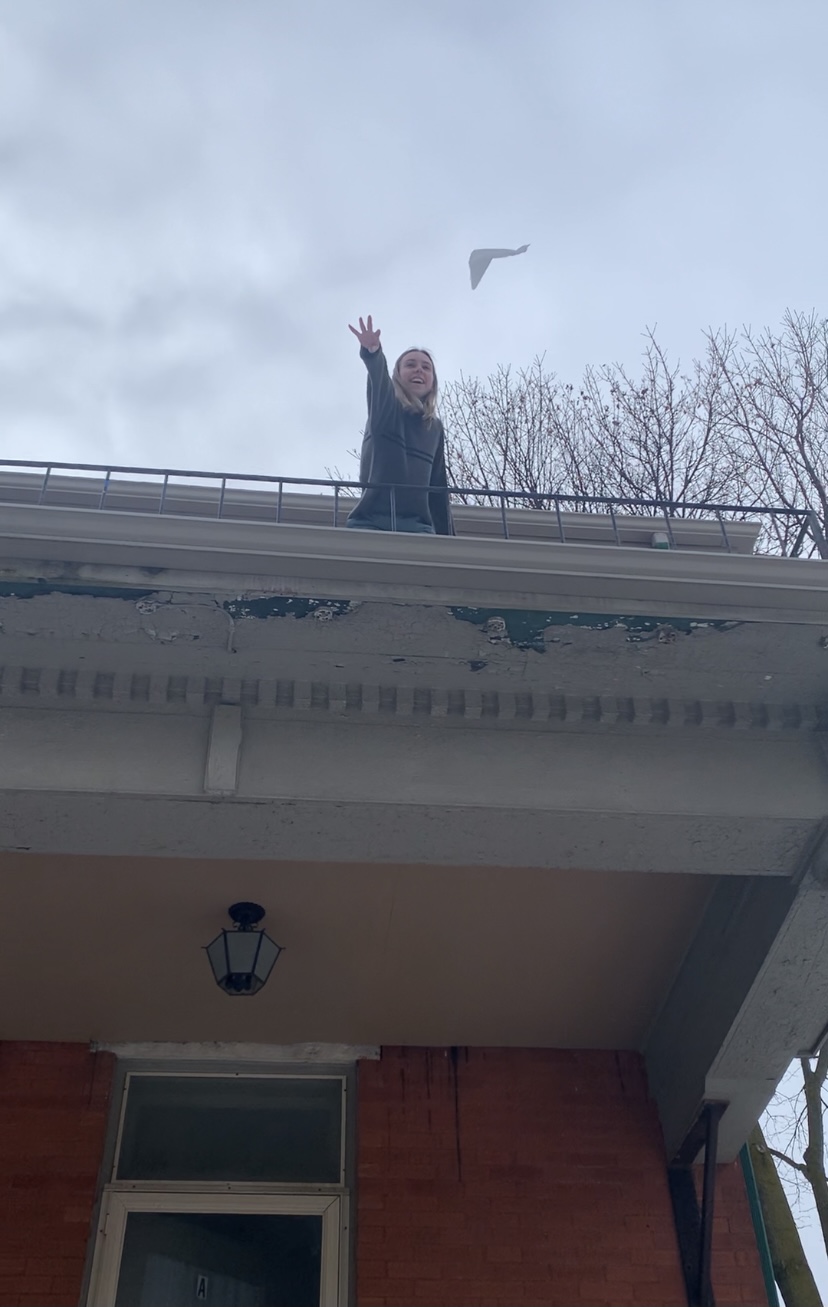
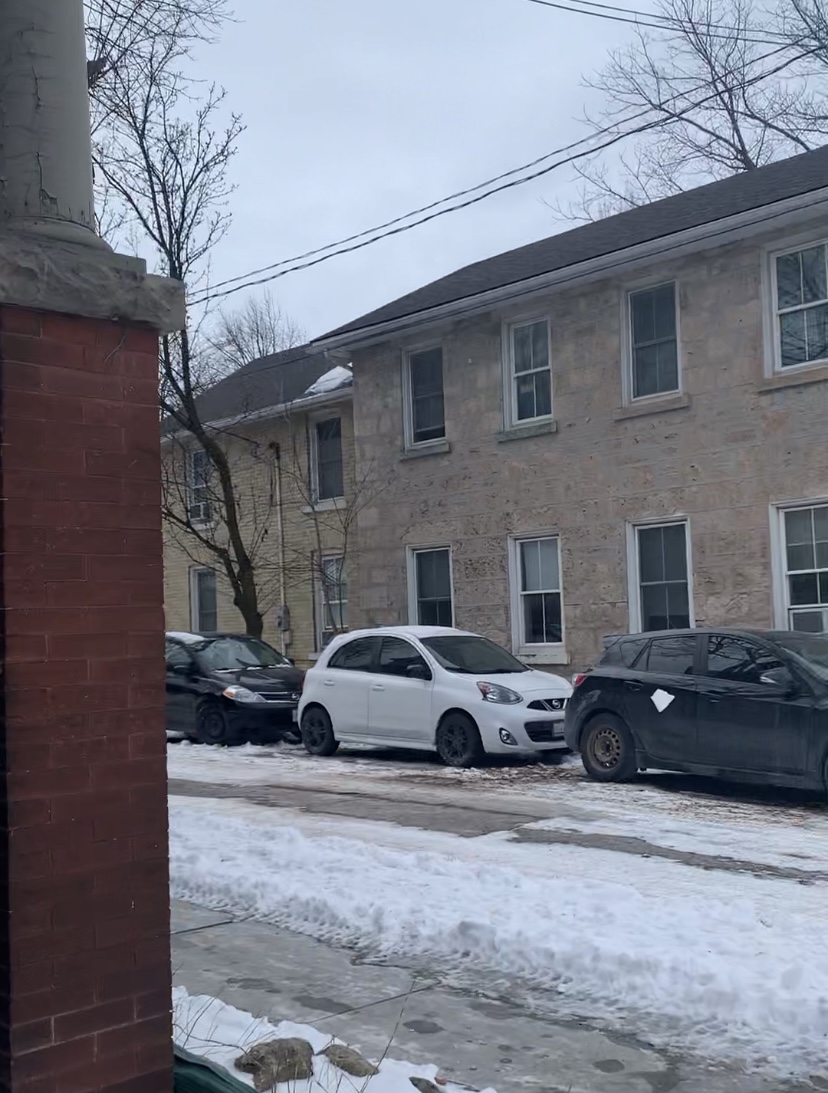
Guess where the tissue is! 
Guess again! 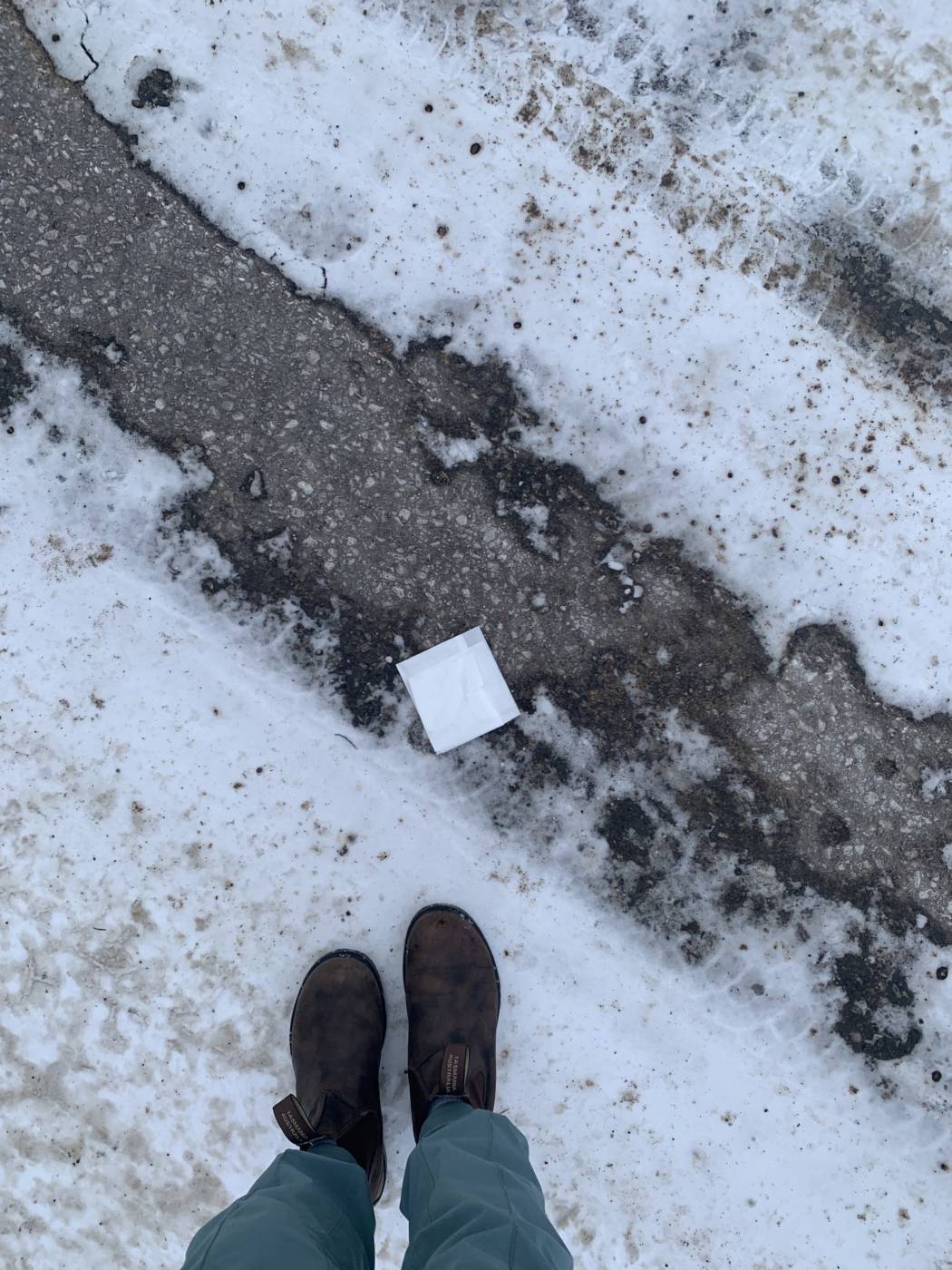
Week 4
This video is a one minute “quarantine” portrait of my mother. She is a teacher and is currently back in the classrooms for in person learning after several weeks of online school. My mom has found quarantine challenging, but the most difficult part has been teaching and guiding her young students through online platforms. To escape from the stress of it all, she loves to go for walks on trails nearby. This one is her favourite and she especially loves the many routes it can go. For this video, she chose to be looking at the map of the conservation area to capture the many possibilities the trails can take you. “I just love coming here and going for walks right as the sun is setting. The tops of the trees glow and the sun shines through the cracks of the trees. It’s so beautiful, it helps me calm down after a busy day at work” she says.
Week 6
Takeaways from the Article:
- The better humans are at expressing their feelings through their facial expressions, the more successful we are
- Facial expressions came before languages
- the face is our main mode of communication
- The first masks were not used to avoid sickness but rather in death rituals
- Through studies it is understood that humans have been making masks for more than 30,000 years
- Masks are protective and medical, but also “stop-gaps” between known and unknown (covid, and what it does to us)
- Awful people wear masks to hide themselves, for example the KKK or villans in movies. Also the masks can act as an element of fear
- Wearing masks can make us feel unseen, and not in touch with our identity
- Wearing a mask for covid is comparative to a woman aging and feeling like she’s less interesting to men
- Wearing a mask can result in us not making an effort in conversations. Feeling less animated and interesting
- Wrinkles of a face is like carrying history
- Your face determines what kind of experiences you will go through – this was proven in John Howard Griffin’s experiment where he (a white man) disguised himself as a black man to have a first hand experience on what it’s like to deal with racism
- Even before the conscious mind begins to process, the brain is activated by face-like objects which alert the observer to the emotional state and identity of the face,
My thoughts:
- It took me some time to get used to wearing masks but I don’t mind it. It doesn’t bother me or make me feel unseen
- I find it difficult to connect with people like cashiers in stores, but I think it has made me more conscious of my words and has encouraged me to express kindness further than just a smile
- I constantly worry about really little kids growing up seeing people wear masks all the time and constantly seeing people on social media. I wonder if it will make them less expressive or more anxious in social settings
Mask Assignment:
For this assignment, I wanted to focus on using paper since all of my schoolwork is completely online and it has been a while sine I have written notes or done work in a paper notebook.
The first mask I have is my face covered in sticky notes of my “to do” list. Throughout the school year, I have found it very useful to write all my tasks on sticky notes to stick them to my calendar and rip them off when I’m done. A lot of the time, it gets very overwhelming to see all the things I have to do, and it feels like they’re taking over and getting in the way of seeing clearly, like what is happening in this photo.
My second mask is very simple. It is an homage to the hard days of the pandemic that I wish I could just copy and paste a smile onto myself. Some days, I even feel like I have done that. When I am struggling to maintain a smile, I look in the mirror and it almost looks like this photo; I have ignored my actual feelings and I’ve taped on a smile to my reflection.
I made the last mask by ripping out facial features from printed out pictures that I’ve used as references for painting portraits. I loved how the different sizes and angles of the features transformed my face to a Picasso-like orientation. It’s me with my own facial features taped on my face, however it doesn’t look natural. It’s me, but it’s not me. Like I created a mask out of my own face.
Week 7
Research and Inspiration:
- Similar to John Cage
- The sound of traffic is acting – it changes in time, it gets louder, and quieter, longer and shorter
- Duschamp – “sculpture musicale” – music isn’t a time art it’s a space art, producing a sculpture
- Listening is more than listening, it’s about the meaning of sound
- Alter Bahnhof
- Ambient and natural background noise that fits with the scene
- Voice speaking on top, describing the scenery and painting the picture of what activity is going on
- Bahnhof’s piece is carried by the visuals in the video so I would have to really describe the setting if I were doing something like this
- Daniel Olson
- Manipulating toy instruments to make a different sound
- It would be cool to get to manipulate sounds
- It sounds like a song, it sounds pleasant, like an actual song
- You wouldn’t know it was created with toy instruments
- I’m interested in doing the same by manipulating a sound to sound different
Ideas for Audio Art:
- Something about my busy street
- Record and manipulate the sounds of sirens that pass by
- Voice over talking about the stories that my roommates and I made up about our neighbourhood
- Voice over people watching and predict the story of people walking by with the sound of cars going by background
- Record sounds that I hear on a daily basis and manipulate them to sound different and fit altogether
- Doors and floors creaking, sirens, people yelling walking by, getting tea, neighbours playing guitar etc.
- Play guitar but with tape on the strings so it doesn’t sound like much, layered with a keyboard that doesn’t have sound connected
- Like Kelly Mark – record the many times in a day that I start singing something and my roommates go along with it
- Singing a note until I’m out of breath
- Find different objects around the house that’s the same pitch, jump cuts like Lee Walton
Audio Project
These are my two audio assignments. I created these pieces by going around my house to find any object that made the note A# when I hit it. The first audio excerpt is me naming the sounds, playing them consecutively, then repeating them and layering them all together. The second audio is a short rhythmic song that I created with each of the sounds.
Week 10
Conceptual Portrait:
Throughout the school year, my thoughts have been very scattered. It takes a lot of effort for me to be able to manage my days, keep up with deadlines, and organize my ideas. In the summer my mom got me this notepad so I had something tangible to write reminders on. I didn’t think I would use it as much as I have, but this notepad has been a lifesaver.
In this collection of photos you will see that I’ve used the notepad to write notes, doodles, daily lists, schedules, and project ideas. You will also see the progression of my small business “Lume”, where I have come up with the title, logo, and a few sweatshirt designs on these pages. When looking over these pages, only I know what list was the aftermath of a mental breakdown, or what tasks I wrote down the day my boyfriend and I broke up. These to-do lists not only helped me manage my days through some tough times, but they also act as a window into my mind over the past year, and it is so fascinating for me to look these over and be transported back in time to each of those days.
If you are wondering why I kept these lists the whole whole year, I don’t have an answer for you. I had no reason why I kept them, but I’m glad that I did for the purpose of this project. As soon as a page was completed, I would rip it off and put it in my drawer. I’m sure there has been a few tossed in the garbage, ripped up, or turned into a mediocre airplane, but for the most part I still have these 20 pages remaining.
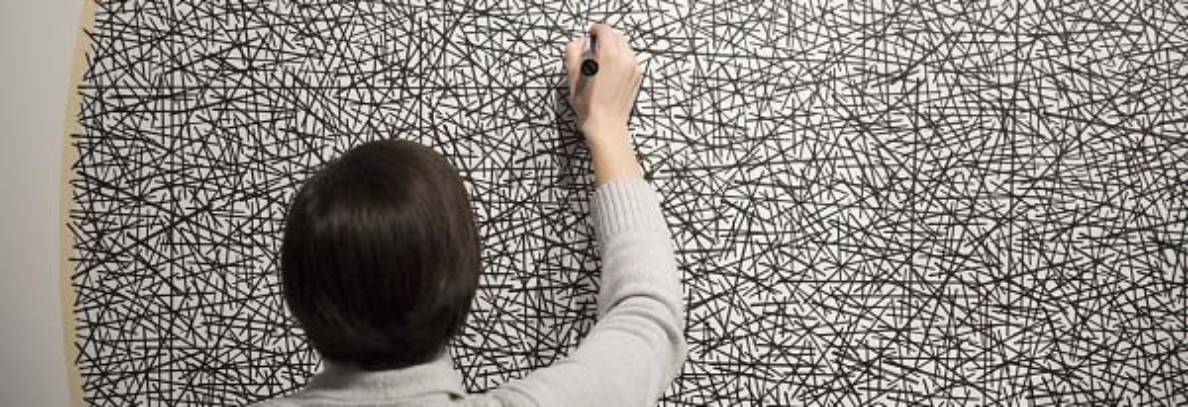




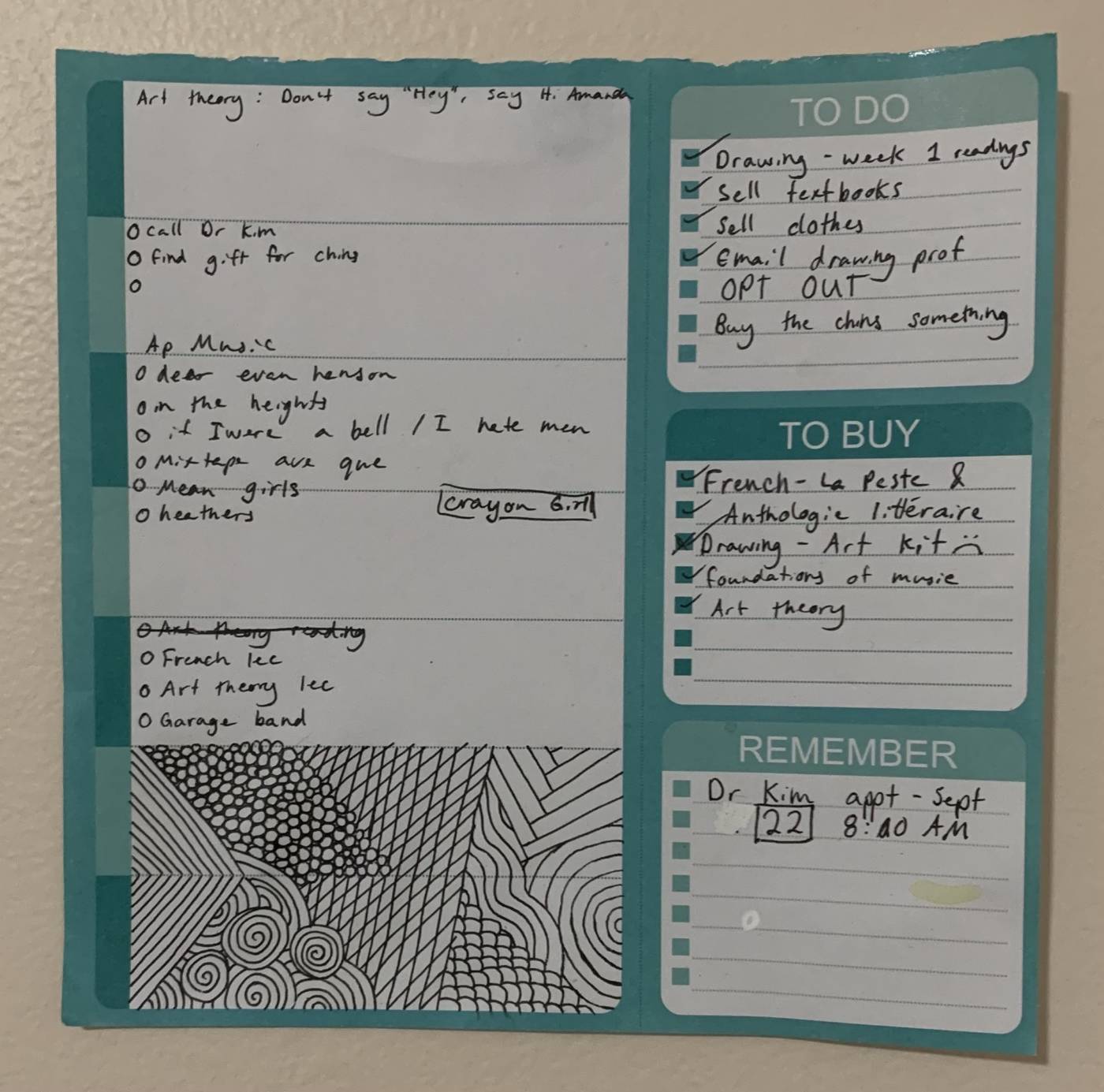
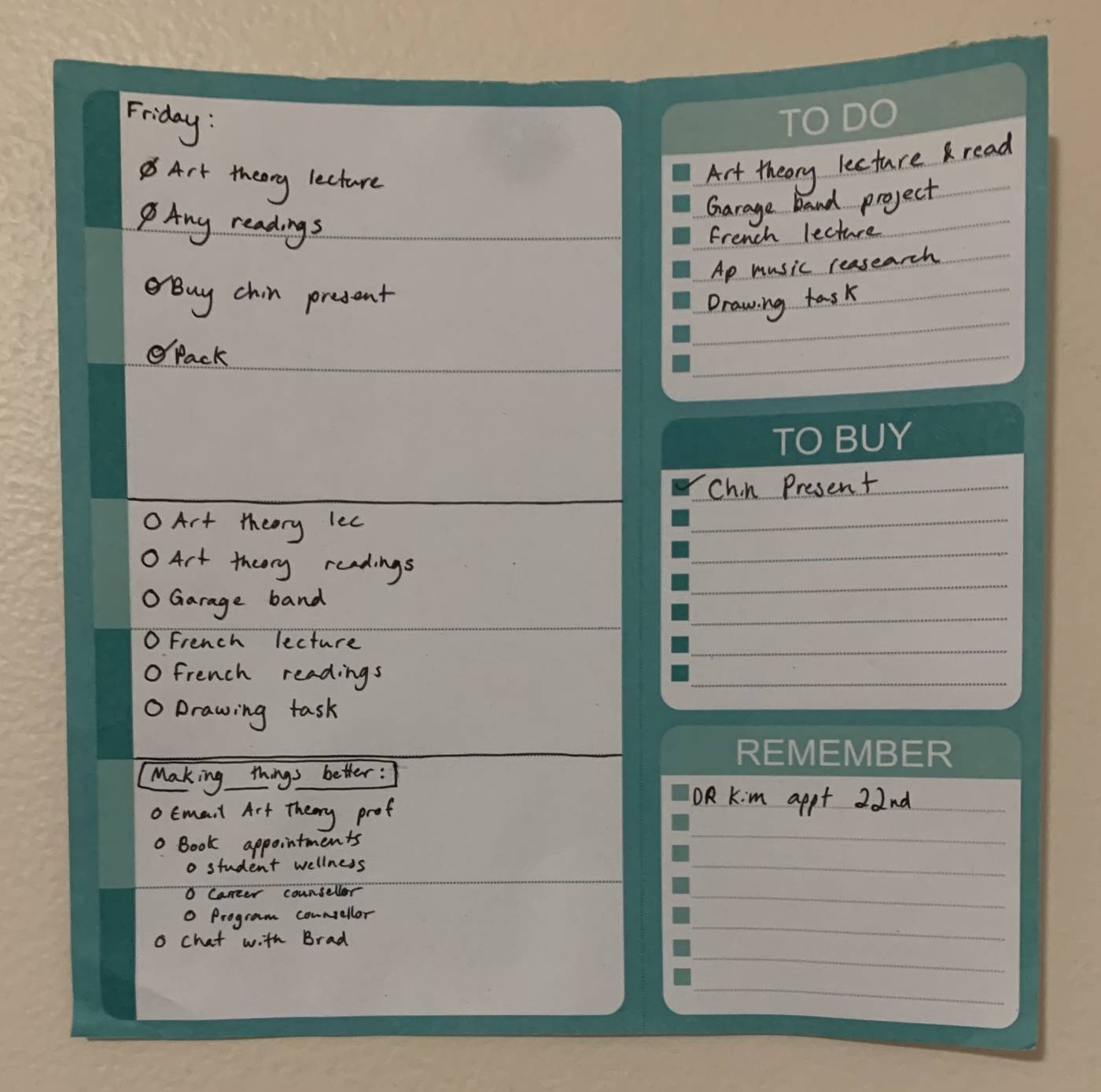

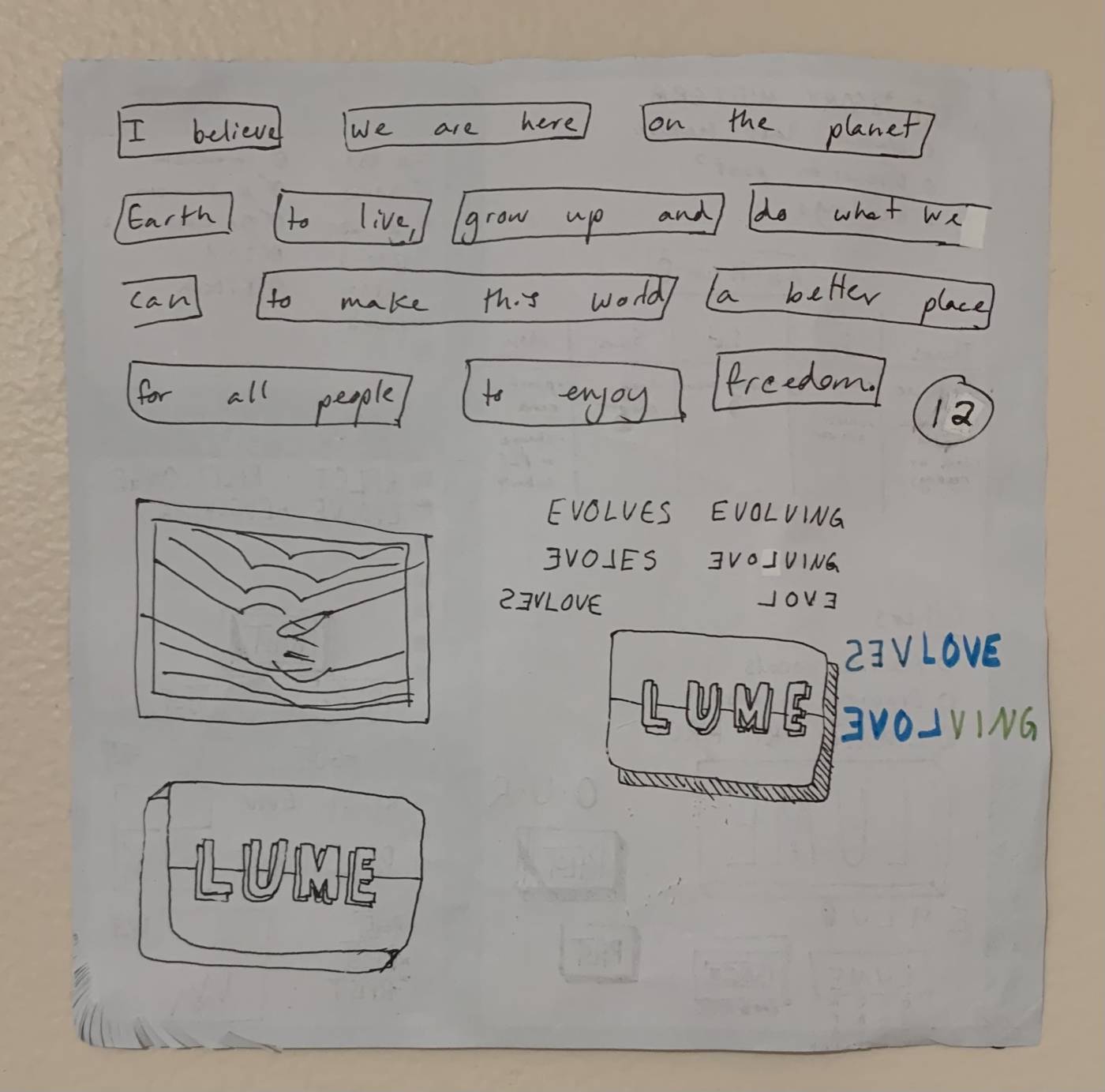

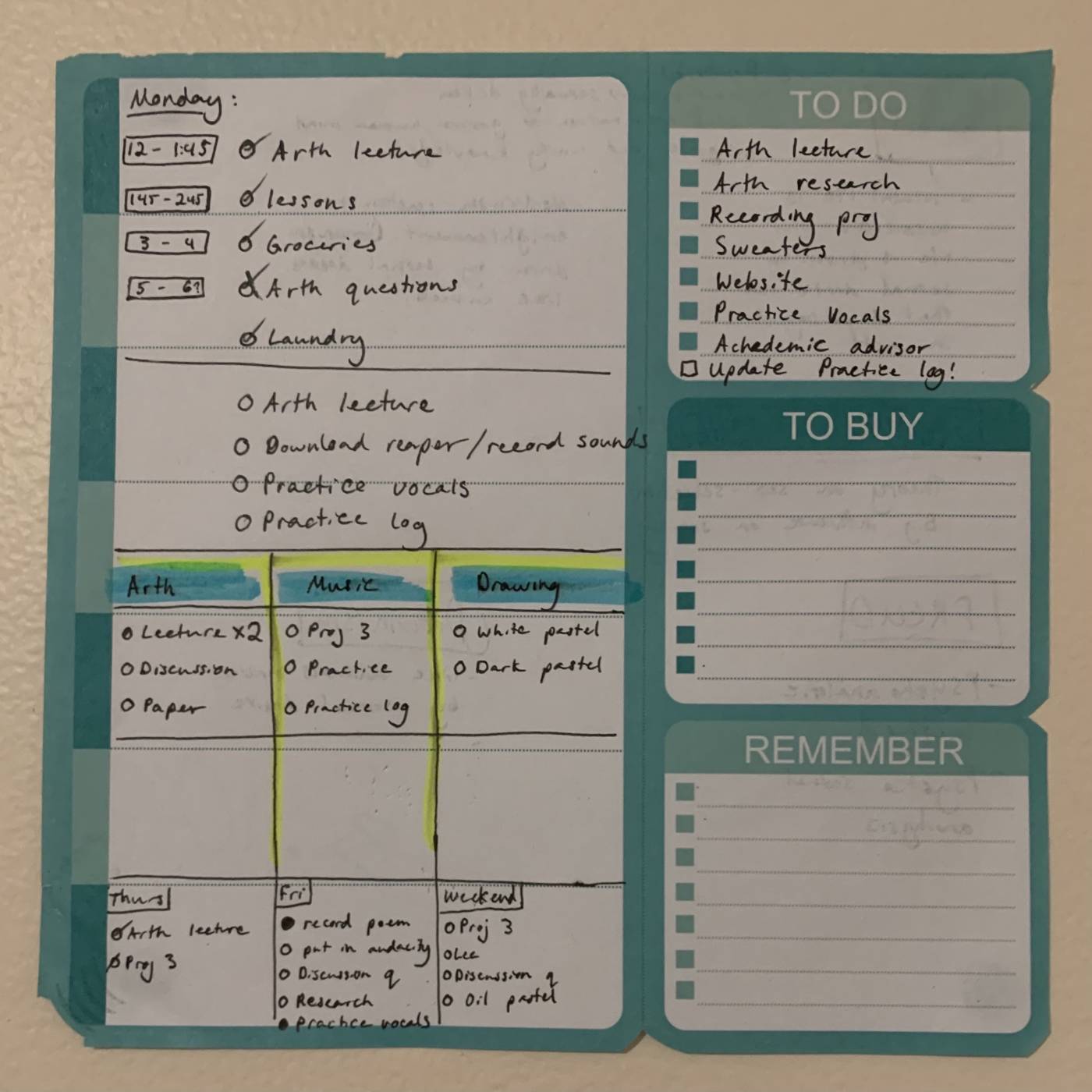


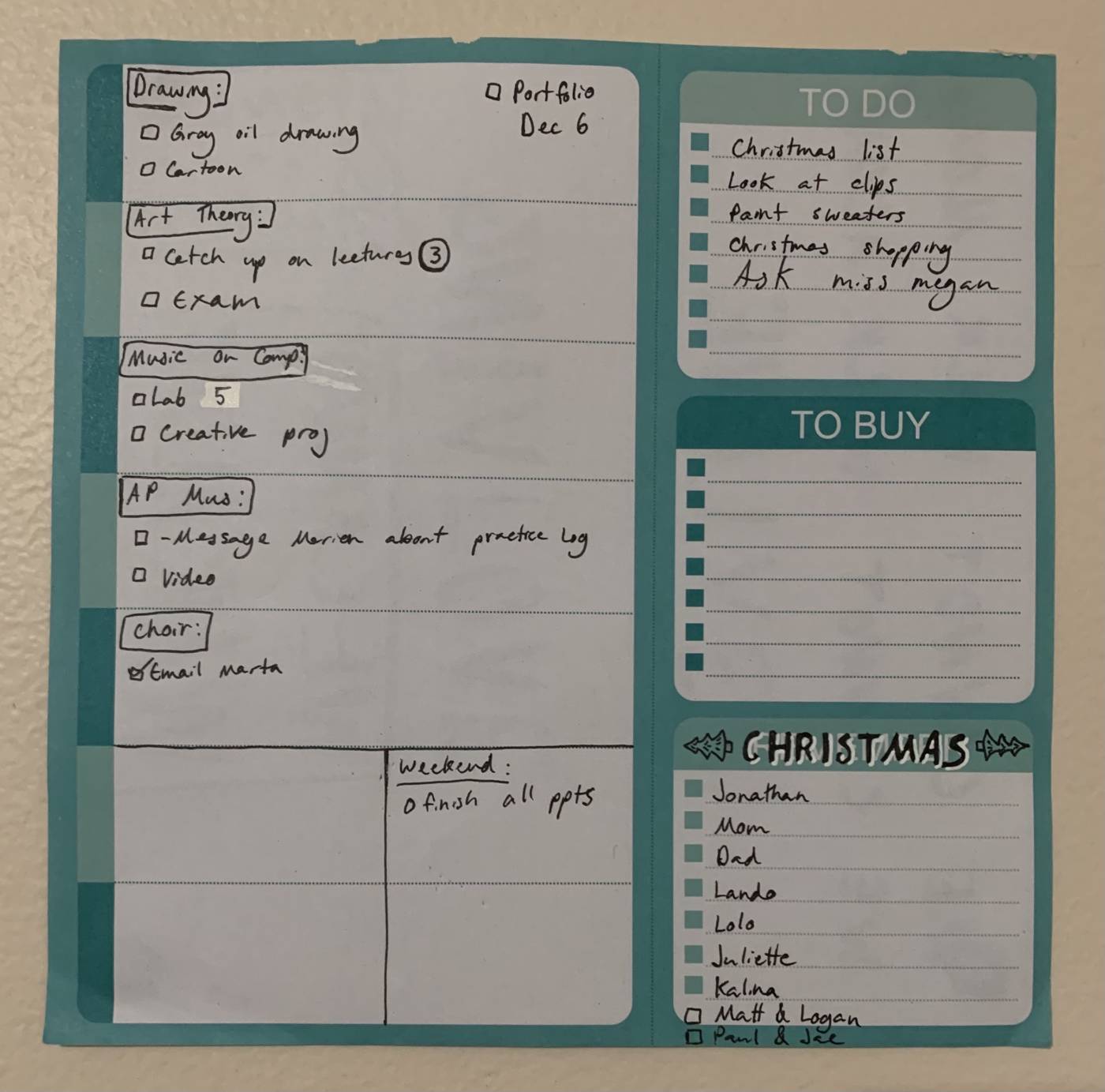

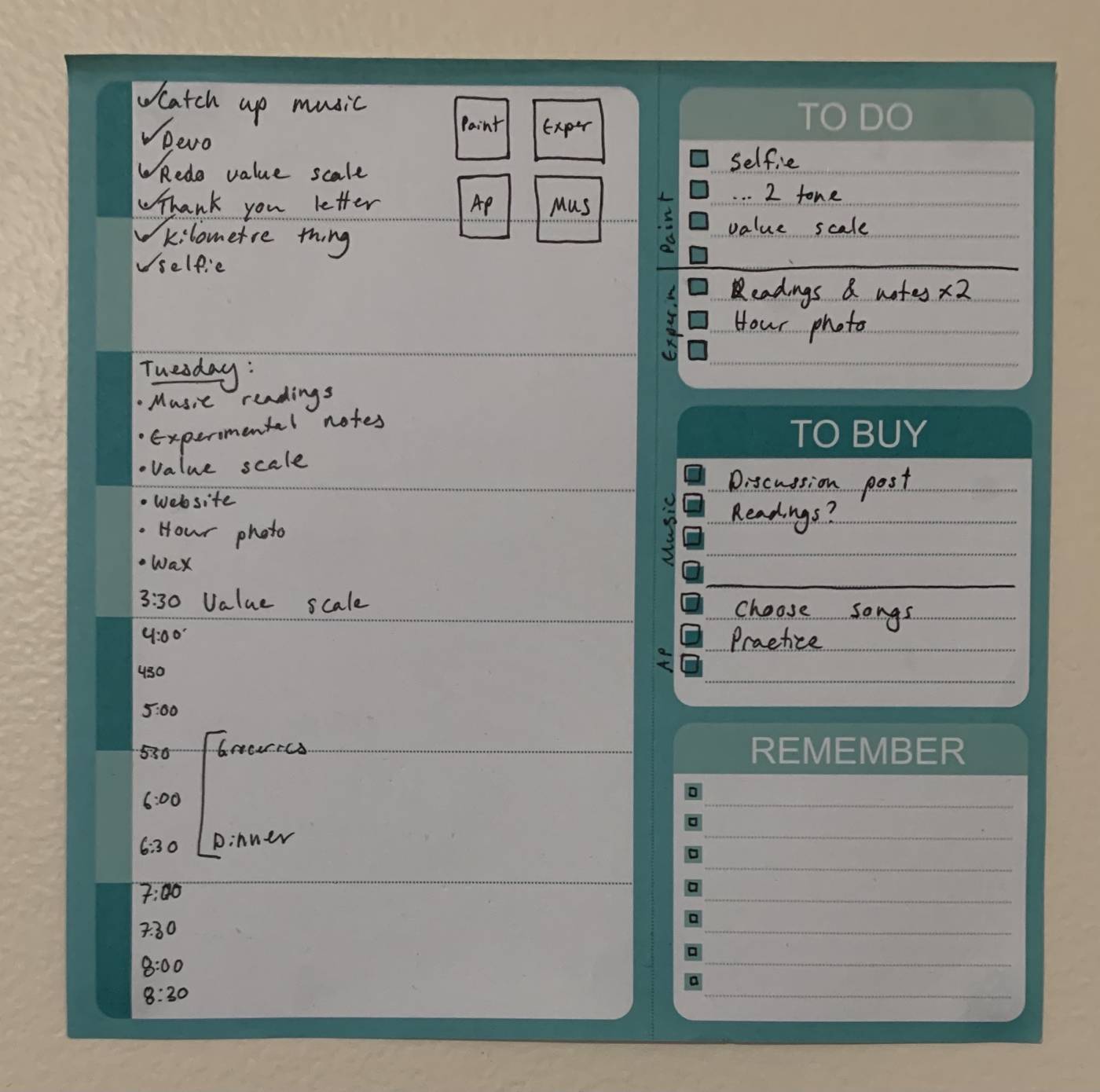
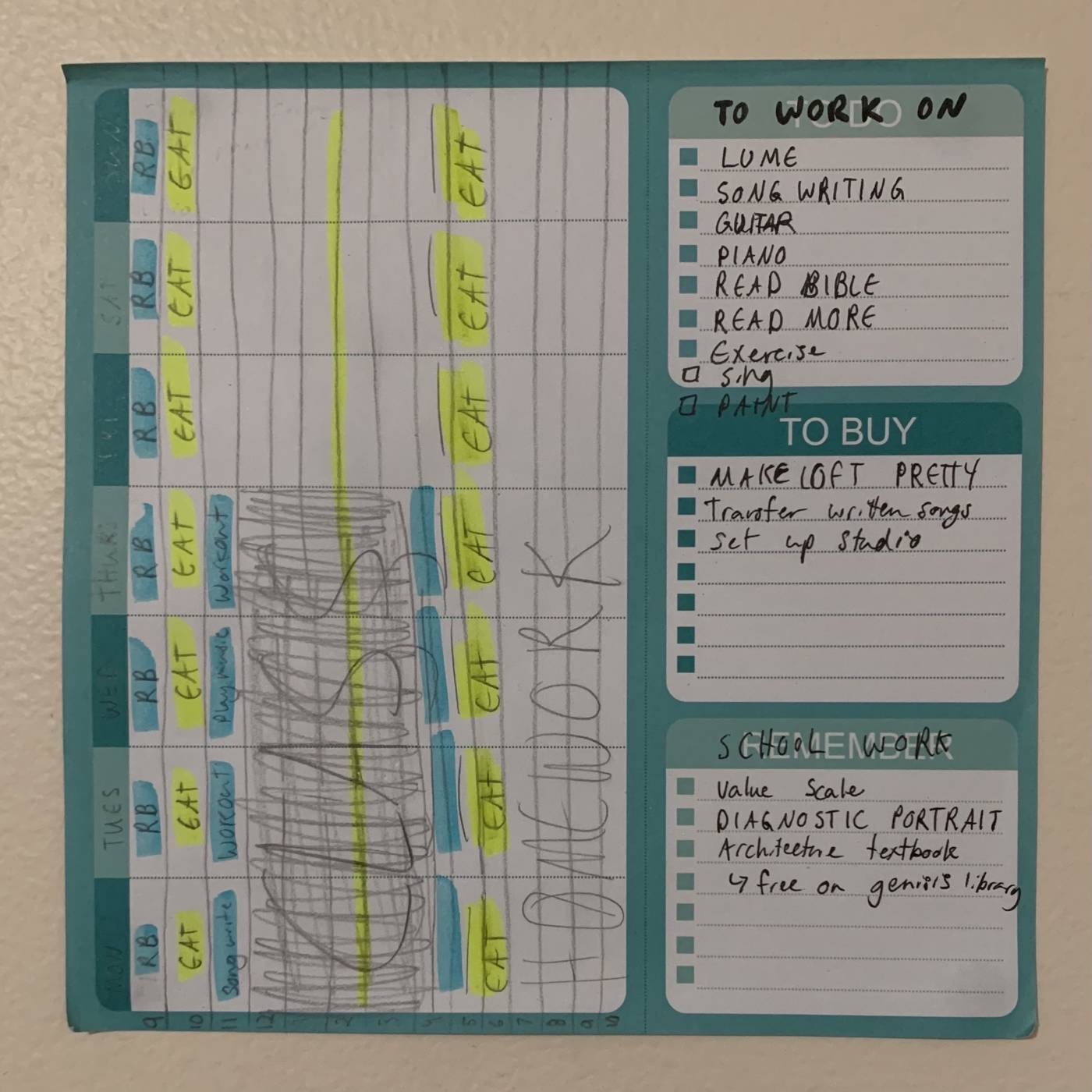

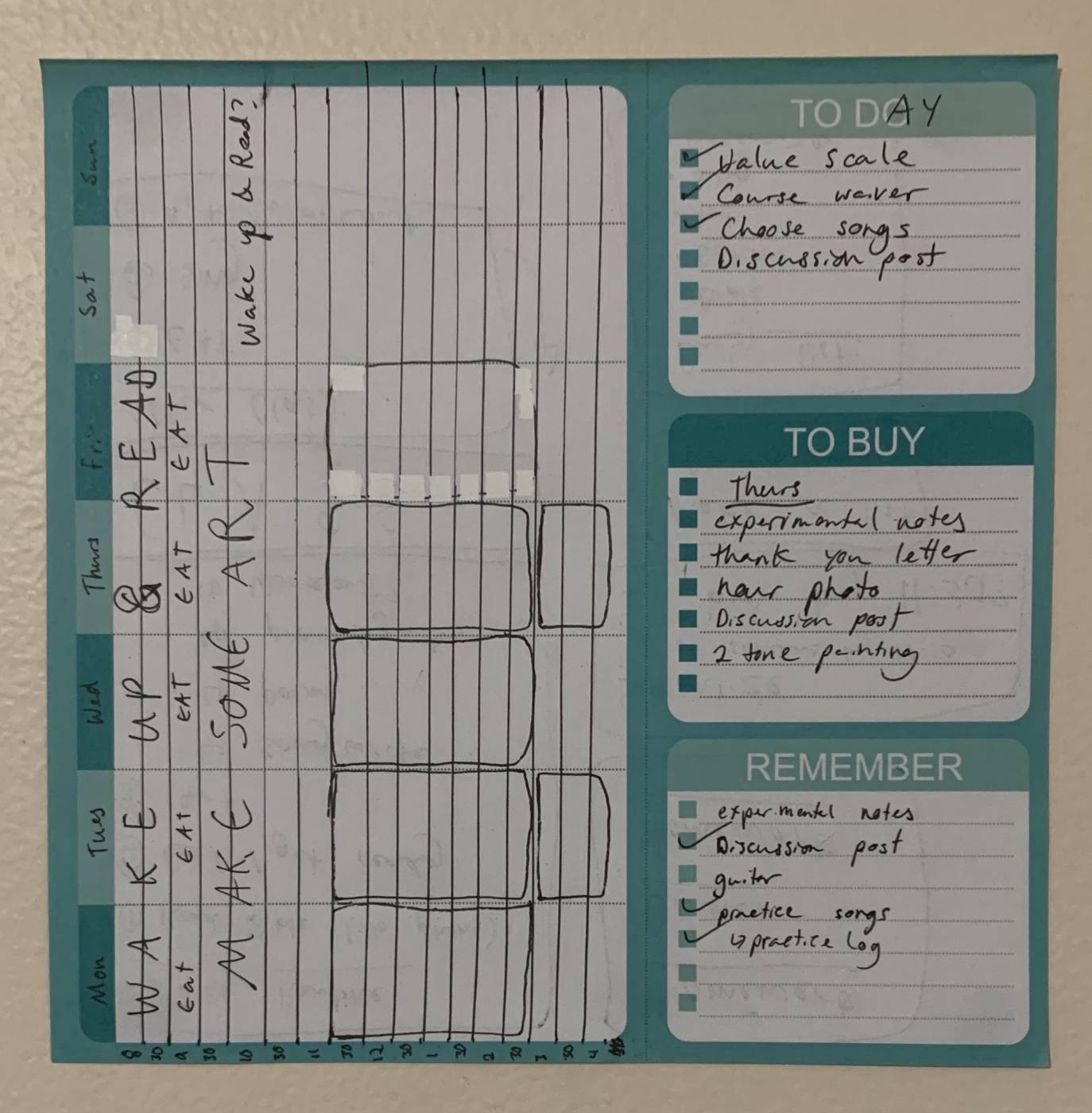
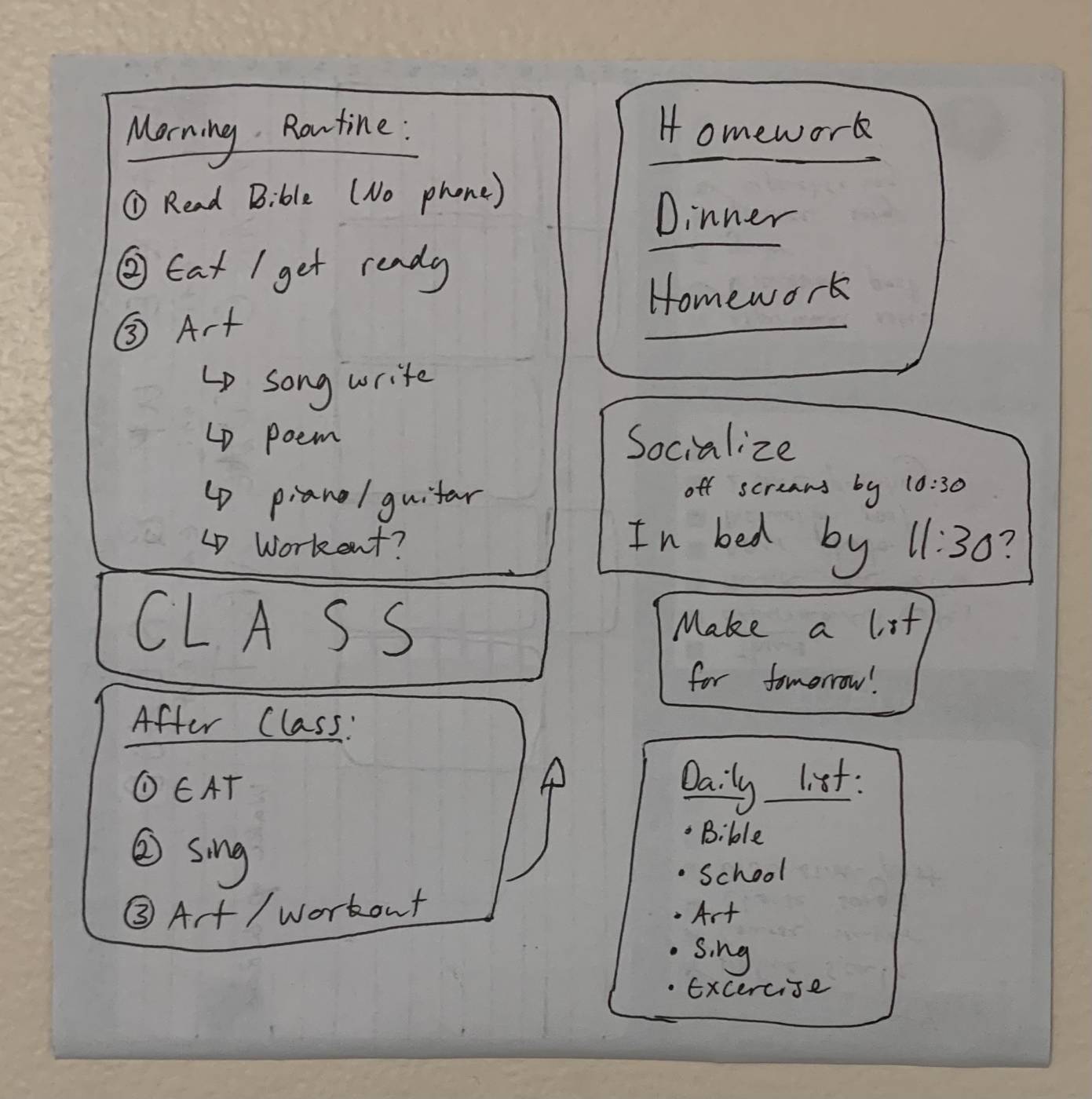

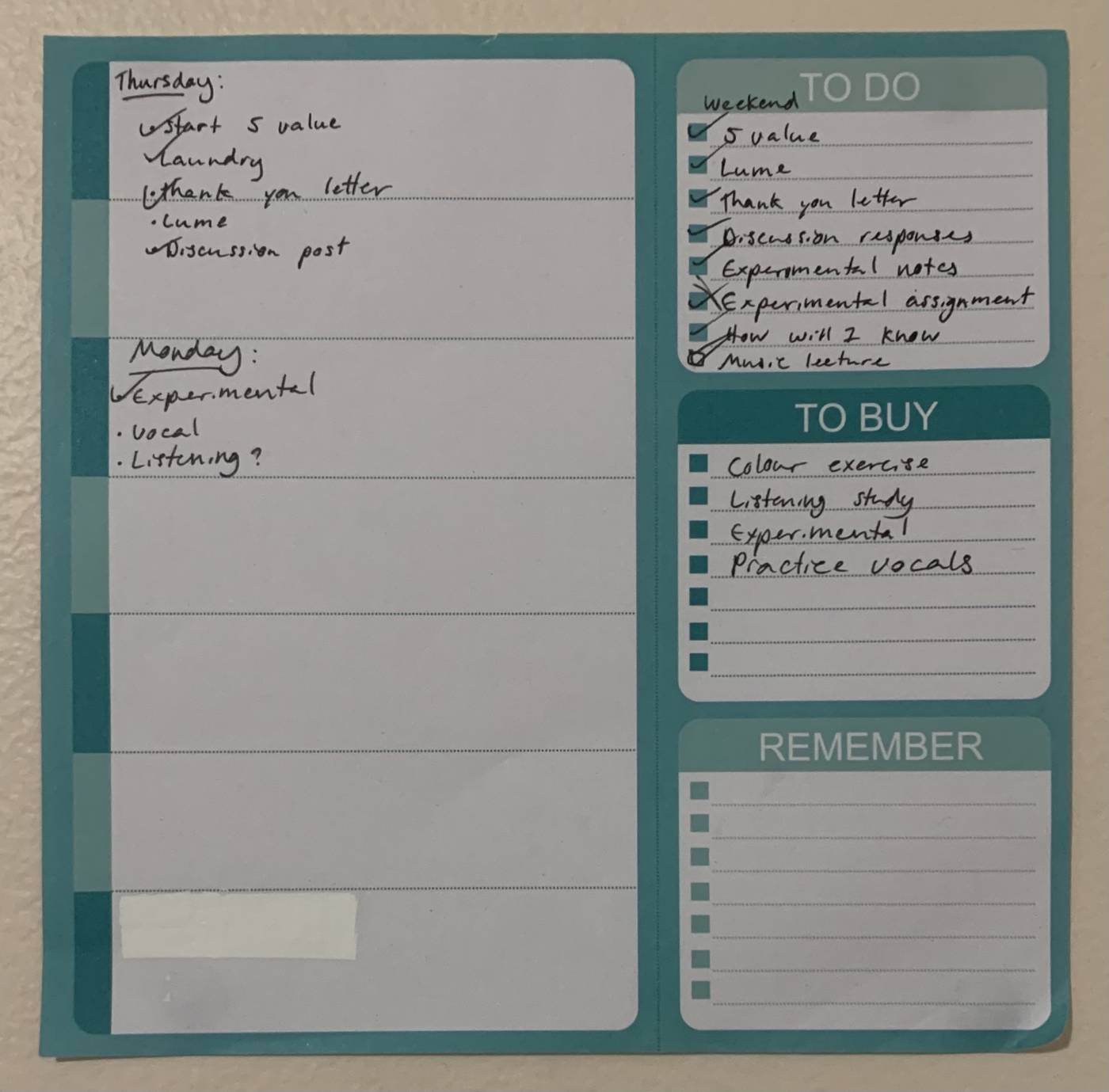


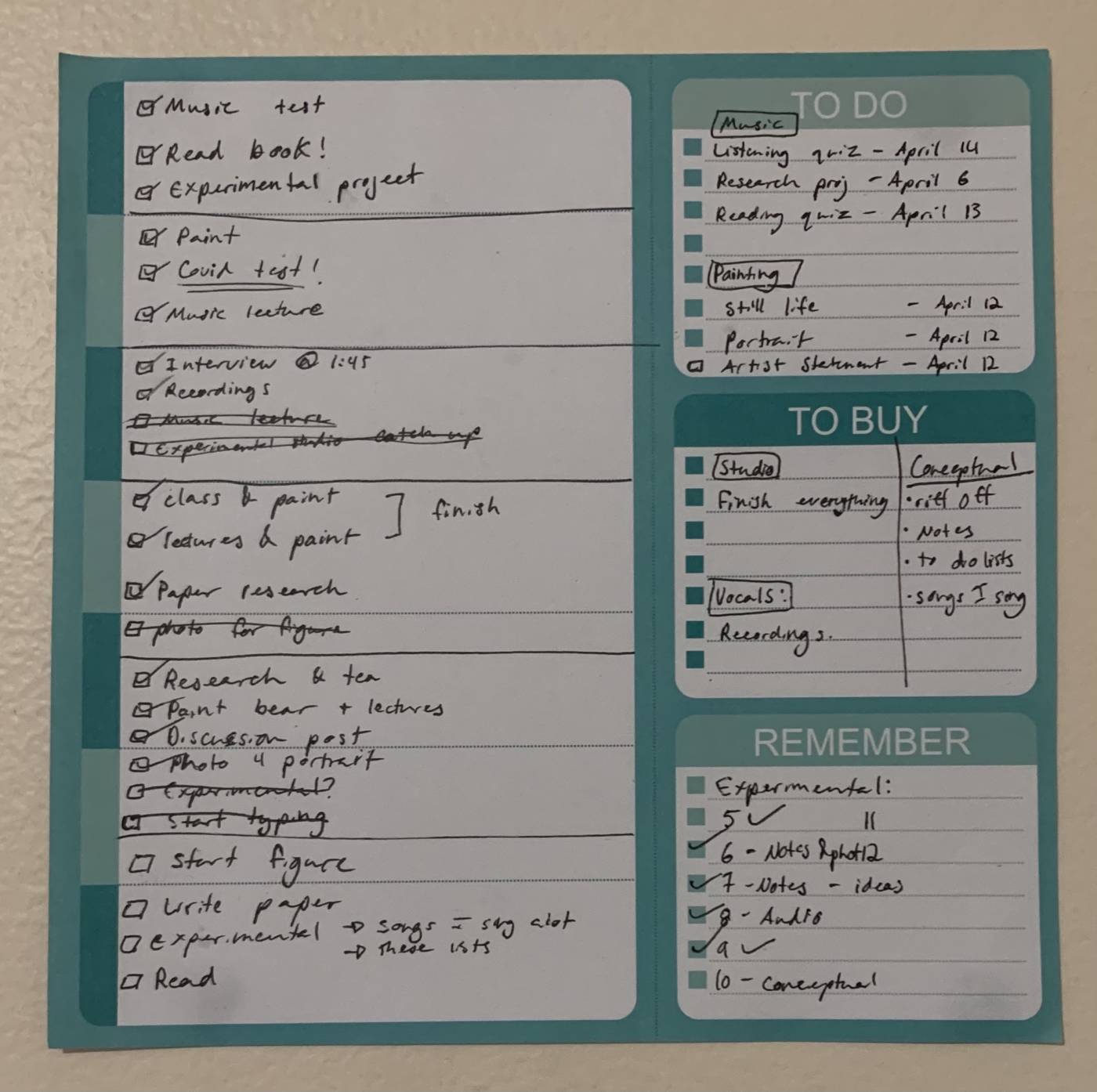
Hi Madelyne,
W1: Notes on Sol Lewitt, Yoko Ono, Nauman complete, Kilometre image and description good – using language/text to express kilometre in a surprising way
W2: Image of Abramovic/Stillness gesture, and description – excellent and thorough notes, and engagement with this material, and I like how you put yourself somewhere unusual, with the logic of the cat – good experimentation where you didn’t know what would happen – makes for an interesting video
W3: 6 Good conceptual sentences, Defenestration image and description complete – perhaps not super exciting? But glad you did something safe! And I appreciate the subtle range of exploration.
W4: 1 Distancing video portrait, and description – very good, shows understanding of Hannah’s portraits, wish we could see your mom from the front though – as a protrait where she shows herself -as in Hannah’s, and to make us relate to her and her voice – consider adding a quote from her to illustrate the portrait.
Overall, good evidence of curiosity and full engagement with material, and very good level of understanding of critical ideas at play, keep improving technical investment and effort,
and keep seeing how far you might go with experimentation and adventurousness.
Thank you for the attendance and engagement in class, and if you would like to talk with me about your work in progress, readings, exercises, one-on-one comments on your work, and grades – send me an email in the morning to book a 15 minute appointment during the optional contact hours: Thursdays 11:30-2:30.
And you can show up to a zoom meeting with Nathan anytime during these hours to ask your questions, and get tech support for using software and finishing your projects:
Mondays and Thursdays 11:30-4pm.